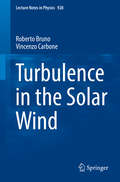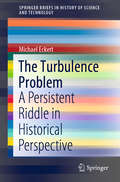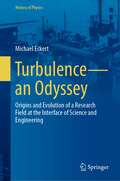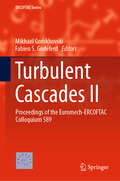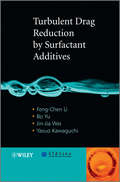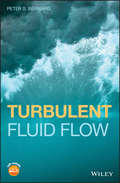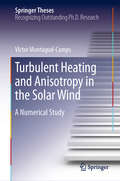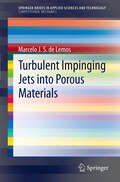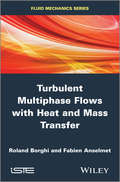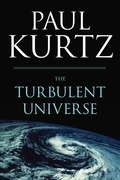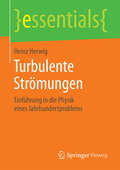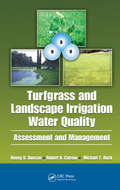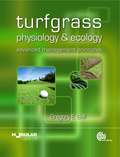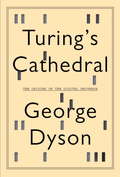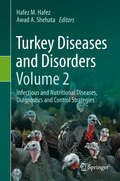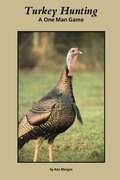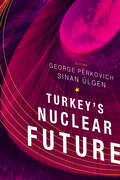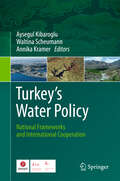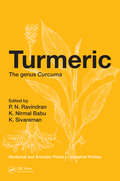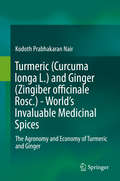- Table View
- List View
Turbulence in Rotating, Stratified and Electrically Conducting Fluids
by P. A. DavidsonThere are two recurring themes in astrophysical and geophysical fluid mechanics: waves and turbulence. This book investigates how turbulence responds to rotation, stratification or magnetic fields, identifying common themes, where they exist, as well as the essential differences which inevitably arise between different classes of flow. The discussion is developed from first principles, making the book suitable for graduate students as well as professional researchers. The author focuses first on the fundamentals and then progresses to such topics as the atmospheric boundary layer, turbulence in the upper atmosphere, turbulence in the core of the earth, zonal winds in the giant planets, turbulence within the interior of the sun, the solar wind, and turbulent flows in accretion discs. The book will appeal to engineers, geophysicists, astrophysicists and applied mathematicians who are interested in naturally occurring turbulent flows.
Turbulence in the Solar Wind
by Roberto Bruno Vincenzo CarboneThis book provides an overview of solar wind turbulence from both the theoretical and observational perspective. It argues that the interplanetary medium offers the best opportunity to directly study turbulent fluctuations in collisionless plasmas. In fact, during expansion, the solar wind evolves towards a state characterized by large-amplitude fluctuations in all observed parameters, which resembles, at least at large scales, the well-known hydrodynamic turbulence. This text starts with historical references to past observations and experiments on turbulent flows. It then introduces the Navier-Stokes equations for a magnetized plasma whose low-frequency turbulence evolution is described within the framework of the MHD approximation. It also considers the scaling of plasma and magnetic field fluctuations and the study of nonlinear energy cascades within the same framework. It reports observations of turbulence in the ecliptic and at high latitude, treating Alfv#65533;nic and compressive fluctuations separately in order to explain the transport of mass, momentum and energy during the expansion. Further, existing models are compared with direct observations in the heliosphere. The problem of self-similar and anomalous fluctuations in the solar wind is then addressed using tools provided by dynamical system theory and discussed on the basis of available models and observations. The book highlights observations of Yaglom's law in solar wind turbulence, which is one of the most important findings in fully developed turbulence and directly related to the long-lasting and still unsolved problem of solar wind plasma heating. Lastly, it includes a short chapter dedicated to the kinetic range of fluctuations, which has recently been receiving more attention from the space plasma community, since this is inherently related to turbulent energy dissipation and consequent plasma heating. It particularly focuses on the nature and role of the fluctuations populating this frequency range, and discusses several model predictions and recent observational findings in this context.
The Turbulence Problem: A Persistent Riddle in Historical Perspective (SpringerBriefs in History of Science and Technology)
by Michael EckertOn the road toward a history of turbulence, this book focuses on what the actors in this research field have identified as the “turbulence problem”. Turbulent flow rose to prominence as one of the most persistent challenges in science. At different times and in different social and disciplinary settings, the nature of this problem has changed in response to changing research agendas. This book does not seek to provide a comprehensive account, but instead an exemplary exposition on the environments in which problems become the subjects of research agendas, with particular emphasis on the first half of the 20th century.
Turbulence—an Odyssey: Origins and Evolution of a Research Field at the Interface of Science and Engineering (History of Physics)
by Michael EckertTurbulence is a research field where high expectations have met with recurrent frustration. It is a common perception among physicists, mathematicians and engineers that there is a "big mystery" behind the phenomenon of turbulence. Its history has also remained anything but well researched. Unlike topics such as quantum theory, which began to attract physics historians as long as fifty years ago, turbulence has - until now - received only little professional historical investigation. In this book, which complements his earlier SpringerBrief "The Turbulence Problem", the author sketches the history of turbulence from the vantage point of its roots (Part I), the basic concepts (Part II) and the formation of a scientific community that regarded turbulence as a research field in its own right (Part III). From this perspective turbulence research appears to undertake an odyssey through uncharted territories. The book follows this development up until a conference in Marseille in the year 1961, which marked the inauguration of turbulence in the words of its organizer as “a new science”. The epilogue contains some observations about turbulence research since 1961. This book provides a rich source of information for all those interested in the history of this major field of basic and applied science.
Turbulent Cascades II: Proceedings of the Euromech-ERCOFTAC Colloquium 589 (ERCOFTAC Series #26)
by Mikhael Gorokhovski Fabien S. GodeferdGathering contributions by the most prominent researchers in a highly specialised field, this proceedings volume clarifies selected aspects of the physics of turbulent cascades and their statistical universalities under complex stationary and non-homogeneous conditions. Here, these conditions are induced by the presence of a gas/liquid interface, inertial particles, strong shear, rotation, MHD and stratification. By proposing different ways to model turbulence effects under these complex conditions, the book will be of considerable interest not only to academic researchers, but also to specialists and junior researchers in the domain of propulsion and power, as well as those whose work involves various applications related to atmospheric, oceanic and planetary physics.
Turbulent Drag Reduction by Surfactant Additives
by Feng-Chen Li Bo Yu Jin-Jia Wei Yasuo KawaguchiTurbulent drag reduction by additives has long been a hot research topic. This phenomenon is inherently associated with multifold expertise. Solutions of drag-reducing additives are usually viscoelastic fluids having complicated rheological properties. Exploring the characteristics of drag-reduced turbulent flows calls for uniquely designed experimental and numerical simulation techniques and elaborate theoretical considerations. Pertinently understanding the turbulent drag reduction mechanism necessities mastering the fundamentals of turbulence and establishing a proper relationship between turbulence and the rheological properties induced by additives. Promoting the applications of the drag reduction phenomenon requires the knowledge from different fields such as chemical engineering, mechanical engineering, municipal engineering, and so on. This book gives a thorough elucidation of the turbulence characteristics and rheological behaviors, theories, special techniques and application issues for drag-reducing flows by surfactant additives based on the state-of-the-art of scientific research results through the latest experimental studies, numerical simulations and theoretical analyses. Covers turbulent drag reduction, heat transfer reduction, complex rheology and the real-world applications of drag reduction Introduces advanced testing techniques, such as PIV, LDA, and their applications in current experiments, illustrated with multiple diagrams and equations Real-world examples of the topic’s increasingly important industrial applications enable readers to implement cost- and energy-saving measures Explains the tools before presenting the research results, to give readers coverage of the subject from both theoretical and experimental viewpoints Consolidates interdisciplinary information on turbulent drag reduction by additives Turbulent Drag Reduction by Surfactant Additives is geared for researchers, graduate students, and engineers in the fields of Fluid Mechanics, Mechanical Engineering, Turbulence, Chemical Engineering, Municipal Engineering. Researchers and practitioners involved in the fields of Flow Control, Chemistry, Computational Fluid Dynamics, Experimental Fluid Dynamics, and Rheology will also find this book to be a much-needed reference on the topic.
Turbulent Flows
by Stephen B. PopeTurbulent Flows is an up-to-date and comprehensive graduate text on this important topic in fluid dynamics. The book consists of two parts: Part I provides a general introduction to turbulent flows, how they behave, how they can be described quantitatively, and their fundamental physical processes. Part II is concerned with different approaches for modeling, or simulating, turbulent flows. Key appendices present the necessary mathematical techniques. While primarily intended for engineering graduate students, this book will also be valuable to students in applied mathematics, physics, oceanography and atmospheric sciences, as well as to researchers and practicing engineers.
Turbulent Fluid Flow
by Peter S. BernardA guide to the essential information needed to model and compute turbulent flows and interpret experiments and numerical simulations Turbulent Fluid Flow offers an authoritative resource to the theories and models encountered in the field of turbulent flow. In this book, the author – a noted expert on the subject – creates a complete picture of the essential information needed for engineers and scientists to carry out turbulent flow studies. This important guide puts the focus on the essential aspects of the subject – including modeling, simulation and the interpretation of experimental data - that fit into the basic needs of engineers that work with turbulent flows in technological design and innovation. Turbulent Fluid Flow offers the basic information that underpins the most recent models and techniques that are currently used to solve turbulent flow challenges. The book provides careful explanations, many supporting figures and detailed mathematical calculations that enable the reader to derive a clear understanding of turbulent fluid flow. This vital resource: • Offers a clear explanation to the models and techniques currently used to solve turbulent flow problems • Provides an up-to-date account of recent experimental and numerical studies probing the physics of canonical turbulent flows • Gives a self-contained treatment of the essential topics in the field of turbulence • Puts the focus on the connection between the subject matter and the goals of fluids engineering • Comes with a detailed syllabus and a solutions manual containing MATLAB codes, available on a password-protected companion website Written for fluids engineers, physicists, applied mathematicians and graduate students in mechanical, aerospace and civil engineering, Turbulent Fluid Flow contains an authoritative resource to the information needed to interpret experiments and carry out turbulent flow studies.
Turbulent Heating and Anisotropy in the Solar Wind: A Numerical Study (Springer Theses)
by Victor Montagud-CampsThis book presents two important new findings. First, it demonstrates from first principles that turbulent heating offers an explanation for the non-adiabatic decay of proton temperature in solar wind. Until now, this was only proved with reduced or phenomenological models. Second, the book demonstrates that the two types of anisotropy of turbulent fluctuations that are observed in solar wind at 1AU originate not only from two distinct classes of conditions near the Sun but also from the imbalance in Alfvén wave populations. These anisotropies do not affect the overall turbulent heating if we take into account the relation observed in solar wind between anisotropy and Alfvén wave imbalance. In terms of the methods used to obtain these achievements, the author shows the need to find a very delicate balance between turbulent decay and expansion losses, so as to directly solve the magnetohydrodynamic equations, including the wind expansion effects.
Turbulent Impinging Jets into Porous Materials
by Marcelo J.S. de LemosThis short book deals with the mathematical modeling of jets impinging porous media. It starts with a short introduction to models describing turbulences in porous media as well as turbulent heat transfer. In its main part, the book presents the heat transfer of impinging jets using a local and a non-local thermal equilibrium approach.
Turbulent Multiphase Flows with Heat and Mass Transfer (Wiley-iste Ser.)
by Roland Borghi Fabien AnselmetNumerous industrial systems or natural environments involve multiphase flows with heat and mass transfer. The authors of this book present the physical modeling of these flows, in a unified way, which can include various physical aspects and several levels of complexity. Thermal engineering and nuclear reactors; the extraction and transport of petroleum products; diesel and rocket engines; chemical engineering reactors and fluidized beds; smoke or aerosol dispersion; landslides and avalanches − the modeling of multiphase flows with heat and mass transfer for all these situations can be developed following a common methodology. This book is devoted to the description of the mathematical bases of how to incorporate adequate physical ingredients in agreement with known experimental facts and how to make the model evolve according to the required complexity. Contents Part 1. Approach and General Equations 1. Towards a Unified Description of Multiphase Flows. 2. Instant Equations for a Piecewise Continuous Medium. 3. Description of a “Mean Multiphase Medium”. 4. Equations for the Mean Continuous Medium. Part 2. Modeling: A Single Approach Adaptable to Multiple Applications 5. The Modeling of Interphase Exchanges. 6. Modeling Turbulent Dispersion Fluxes. 7. Modeling the Mean Gas–Liquid Interface Area per Unit Volume. 8. “Large Eddy Simulation” Style Models. 9. Contribution of Thermodynamics of Irreversible Processes. 10. Experimental Methods. 11. Some Experimental Results Pertaining to Multiphase Flow Properties that Are Still Little Understood. Part 3. From Fluidized Beds to Granular Media 12. Fluidized Beds. 13. Generalizations for Granular Media. 14. Modeling of Cauchy Tensor of Sliding Contacts. 15. Modeling the Kinetic Cauchy Stress Tensor. Part 4. Studying Fluctuations and Probability Densities 16. Fluctuations of the Gas Phase in Reactive Two-Phase Media. 17. Temperature Fluctuations in Condensed Phases. 18. Study of the PDF for Velocity Fluctuations and Sizes of Parcels. About the Authors Roland Borghi is Professor Emeritus at Ecole Centrale Marseille in France and works as a consultant in the space, petrol and automobile sectors. His research activities cover fluid mechanics, combustion and flames, and multi-phase and granular flows. He was a member of the CNRS scientific committee and a laureate of the French Academy of Science. Fabien Anselmet is Professor at Ecole Centrale Marseille in France. His research activities focus on the turbulence of fluids and its varied applications in industry and in fields linked to the environment. With a unified, didactic style, this text presents tangible models of multiphase flows with heat and mass transfer with attention to various levels of complexities. It addresses thermal engineering and nuclear reactors, extraction and transport of petroleum products, diesel engines and rocket engines, chemical engineering reactors and fluidized beds, smoke or aerosol dispersion, and landslides and avalanches. Engineers, researchers, and scientists will appreciate the discussions of modeling principles, flows and granular media, and fluctuations around averages.
The Turbulent Universe
by Paul KurtzIn his final book, the late Paul Kurtz outlines his personal vision for a planetary ethics inspired by scientific wisdom. Blending realism and optimism, he lays out the basic principles of an ethical approach that he calls humanist eupraxsophy--that is, the application of practical moral choices inspired by scientific wisdom. Emphasizing the dramatic character of the biosphere, human affairs, and the physical universe itself, Kurtz has structured the book in terms of an operatic scenario, with an overture, intermezzo, nine acts, and a grand finale. Citing the emergence of a new planetary civilization, he proposes the development of a planetary ethics based on universal human rights, free scientific inquiry unfettered by dogma, an attitude of exuberance toward human potentials, and courage and determination in the face of the daunting challenges of our time. Kurtz concludes on an enthusiastic note: there is meaning to be found in creative human endeavors as well as a sense of awe and profound reverence inspired by the spectacle of the enormous universe and the prospects for the human adventure.
Turbulente Strömungen: Einführung in die Physik eines Jahrhundertproblems (essentials)
by Heinz HerwigHeinz Herwig zeigt, dass turbulente Strömungen in Natur, Technik und im Alltag die Regel sind und nicht etwa die Ausnahme. Nicht zuletzt ist dies einer der Gründe, warum man sich mit der Physik turbulenter Strömungen befassen sollte. Dies geschieht hier anhand theoretischer und praktischer Fragestellungen. Turbulenz ist in diesem essential nicht als eigenständiges Phänomen gemeint, sondern tritt im Zusammenhang mit Strömungen von gasförmigen oder flüssigen Medien auf.
Turfgrass and Landscape Irrigation Water Quality: Assessment and Management
by Robert Carrow Ronny R. Duncan Michael T. HuckWith the increased use of alternative irrigation water sources on turfgrass and landscape sites, their management is becoming more complex and whole ecosystems-oriented. Yet few turfgrass managers have received formal training in the intricacies of irrigation water. Turfgrass and Landscape Irrigation Water Quality: Assessment and Management provide
Turfgrass Insects of the United States and Canada
by Patricia J. VittumThe first edition of this reference work became known as the bible of turfgrass entomology upon publication in 1987. It has proved invaluable to professional entomologists, commercial turf managers, and golf course superintendents and has been used widely in college extension courses. This classic of the field is now in its third edition, providing up-to-date and complete coverage of turfgrass pests in the continental United States, Hawaii, and southern Canada.This revised volume integrates all relevant research from the previous two decades. It provides expanded coverage of several pest species, including the annual bluegrass weevil, invasive crane fly species, chinch bugs, billbugs, mole crickets, and white grubs. Patricia J. Vittum also provides detailed information on the biology and ecology of all major pests and includes the most current information on conditions that favor insect development and biological control strategies pertinent to each species.This edition will include more than 100 black-and-white images, including diagrams of life cycles, sketches of morphological characteristics, and charts highlighting seasonal activity. The book also includes 72 full-color plates (more than 500 color images), showing closeup pictures of most of the key insects (adult and immature stages) and damaged turf. The reader should be able to identify most turf insects through the use of this text. It is a critical reference work that any serious turf professional should own.
Turfgrass Physiology and Ecology
by Gregory BellIn order to face new challenges and unique situations in turfgrass management, students need to understand why specific management practices work and how to adjust them based on plants' requirements. Explaining the physiological needs of turfgrass plants, this advanced textbook outlines the management techniques that help supply those needs. Chapters discuss a range of practices and methods to cope with stress under both normal and less than optimum conditions, providing the decision making tools for improvement based on changing environmental conditions. This book presents a unique perspective of both science and practical management principles that will be applicable to all turfgrass sectors.
Turing's Cathedral
by George Dyson"It is possible to invent a single machine which can be used to compute any computable sequence," twenty-four-year-old Alan Turing announced in 1936. In Turing's Cathedral, George Dyson focuses on a small group of men and women, led by John von Neumann at the Institute for Advanced Study in Princeton, New Jersey, who built one of the first computers to realize Alan Turing's vision of a Universal Machine. Their work would break the distinction between numbers that mean things and numbers that do things--and our universe would never be the same. Using five kilobytes of memory (the amount allocated to displaying the cursor on a computer desktop of today), they achieved unprecedented success in both weather prediction and nuclear weapons design, while tackling, in their spare time, problems ranging from the evolution of viruses to the evolution of stars. Dyson's account, both historic and prophetic, sheds important new light on how the digital universe exploded in the aftermath of World War II. The proliferation of both codes and machines was paralleled by two historic developments: the decoding of self-replicating sequences in biology and the invention of the hydrogen bomb. It's no coincidence that the most destructive and the most constructive of human inventions appeared at exactly the same time. How did code take over the world? In retracing how Alan Turing's one-dimensional model became John von Neumann's two-dimensional implementation, Turing's Cathedral offers a series of provocative suggestions as to where the digital universe, now fully three-dimensional, may be heading next.
Turing's Legacy: Developments from Turing's Ideas in Logic
by Rod DowneyAlan Turing was an inspirational figure who is now recognised as a genius of modern mathematics. In addition to leading the Allied forces' code-breaking effort at Bletchley Park in World War II, he proposed the theoretical foundations of modern computing and anticipated developments in areas from information theory to computer chess. His ideas have been extraordinarily influential in modern mathematics and this book traces such developments by bringing together essays by leading experts in logic, artificial intelligence, computability theory and related areas. Together, they give insight into this fascinating man, the development of modern logic, and the history of ideas. The articles within cover a diverse selection of topics, such as the development of formal proof, differing views on the Church–Turing thesis, the development of combinatorial group theory, and Turing's work on randomness which foresaw the ideas of algorithmic randomness that would emerge many years later.
Turkana Boy
by Jean-François Beauchemin Jessica MooreIn this contemplative novel-poem, Jean-François Beauchemin invites us to share in the inner world of the grieving Mr. Bartolomé, who, following the mysterious disappearance of his young son, wanders and wonders, seeking to transcend his pain by encountering something larger than himself. Continuously occupied by the memory of his lost son, Bartolomé's quest leads him from the city to the countryside and then to the edge of the ocean, where he marvels at the beauty of nature but cannot penetrate its mysteries.Through reference to the two-million-year-old "Turkana Boy," the fossilized remains of a boy found in 1984 near Lake Turkana, Kenya, Beauchemin addresses processes of memory and the long history of human evolution. Beauchemin's character Bartolomé sees in the lives of the boys-separated by nearly two million years-a kind of twin destiny. Has the passage of millennia changed the intensity of human feeling at the loss of blood relations? "Who knows what they had felt? Had the same emotions, those associated with incommensurable loss, broken their bodies, as they had his? Over and above morphological differences sculpted by the passage of millennia, was there something resembling a permanence of feeling, a sort of eternity for the murmuring of the heart, transmitted through the ages by the bonds of blood?"Turkana Boy offers a poignant examination of grieving and one man's search for understanding. This surrealist narrative is punctuated with magnificent musings on the world and startling questions about what it means to be alive.
Turkey Diseases and Disorders Volume 2: Infectious and Nutritional Diseases, Diagnostics and Control Strategies
by Hafez M. Hafez Awad A. ShehataThis volume 2 of a two-volume work provides an overview of the current state of knowledge on the most common viral and parasitic diseases in turkeys. Each chapter is dedicated to a specific infectious disease and provides information on pathogenesis, symptoms and therapeutic strategies. The book also addresses nutritional diseases in fattening turkeys, and introduces diagnostic techniques as well as disease prevention and control strategies. The clear and structured layout allows the reader to refer to it quickly. This book is an indispensable guide for veterinarians, researchers and professionals working in turkey production and health.
Turkey Hunting: A One Man Game
by Kenny Morgan William YarbroughTURKEY HUNTING, A ONE MAN GAME, by Ken Morgan, is a hardback, color edition (1987) that recalls a lifetime of hunting lessons. This turkey hunting book lays out some blueprints for all aspects of wild turkey hunting and sprinkles the reader with generous doses of facts. <p><p>The author has also included a memorization chart that details the best turkey calling sounds to make in each hunting circumstance, and the area of our attitudes and values in turkey hunting is addressed. In addition, the author's appealing storytelling style, as well as his well-founded observations and insights into wild turkey behavior and biology, make Kenny Morgan's book one that you will want to read again and again.
Turkey's Nuclear Future
by Sinan Ülgen George PerkovichTurkey, with a robust modern economy and growing energy needs, is pursuing a switch to nuclear power. But that shift is occurring in an environment fraught with security challenges: Turkey borders Iraq, Syria, and Iran-all states with nuclear or WMD ambitions or capabilities. As a NATO member, Turkey also hosts U.S. nuclear bombs on its territory, although some question the durability of this relationship. This dynamic has naturally led to speculation that Turkish leaders might someday consider moving beyond a civilian course to develop nuclear weapons. Yet there has been remarkably little informed analysis and debate on Turkey's nuclear future, either within the country or in broader international society. This volume explores the current status and trajectory of Turkey's nuclear program, adding historical perspective, analytical rigor, and strategic insight.
Turkey's Water Policy: National Frameworks and International Cooperation
by Annika Kramer Waltina Scheumann Aysegul KibarogluWater is a strategic natural resource of vital importance to all nations. As such it has been the cause of several international disputes. For Turkey especially, water is crucial to social and economic development. Turkey's current national water regime that emphasises water resources development and management for productive uses, however, faces growing environmental concerns and international criticism regarding transboundary water cooperation. Furthermore, EU accession requires Turkey to adopt an extensive and ambitious body of EU water law. To understand Turkey's position to international water law, the national policies and socio-economic circumstances that impact water resources management need to be considered. This book fills the existing knowledge gap through a broad perspective and analysis of the current state of Turkey's water policy and its management of both national and transboundary waters. It is a unique undertaking that brings together Turkish and international authors, practitioners and academics, covering all aspects of water management
Turmeric: The genus Curcuma (Medicinal and Aromatic Plants - Industrial Profiles)
by P. N. Ravindran K. Nirmal Babu K. SivaramanFor the last 6000 years turmeric has been used in Ayurvedic medicine to alleviate pain, balance digestion, purify body and mind, clear skin diseases, expel phlegm, and invigorate the blood. Nowadays, this plant has acquired great importance with its anti-aging, anti-cancer, anti-Altzheimer, antioxidant, and a variety of other medicinal properties.
Turmeric (Curcuma longa L.) and Ginger (Zingiber officinale Rosc.) - World's Invaluable Medicinal Spices: The Agronomy and Economy of Turmeric and Ginger
by Kodoth Prabhakaran NairThis book discusses the various aspects, from production to marketing of turmeric and ginger, the world’s two most important and invaluable medicinal spice crops. The book begins with their origin and history, global spread, and goes on to describe the botany, production agronomy, fertilizer practices, pest management, post-harvest technology, pharmacology and nutraceutical uses. The book presents the economy, import-export and world markets involved with reference to turmeric and ginger. It would be a benchmark and an important reference source for scientists, students, both undergraduate and post graduate, studying agriculture and food sciences and policy makers. It would be of great interest to professionals and industry involved in spice trade.

